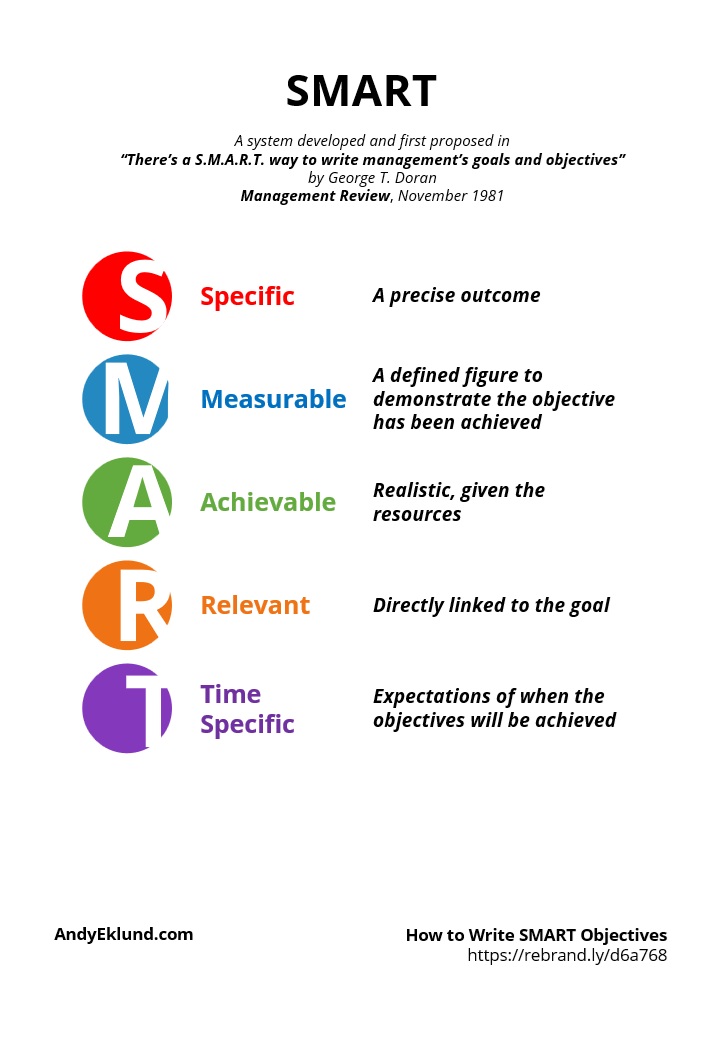First outlined by George T. Doran in his 1981 article in Management Review, the system of SMART objectives is one of the most well-known method for writing objectives.
Yes, there’s been a number of variations (usually to sell a book or two – you can ignore them).
The original is still the simplest and memorable.
Use the blue arrow, bottom right, to jump back to the top.
Specific
- A precise outcome which describes precisely the necessary success
Measurable
- A defined and objective demonstration of what has to be achieved: by number, rate, share, percentage or frequency
- Measure the behaviour or outcome enabling you to identify not just completion, but key milestones or progress if necessary
Achievable
- Realistic, given all available resources
- Be careful of being too aggressive with your objectives; if they’re unrealistic, your team could be left feeling demoralised, discouraged or incompetent
Relevant
- Directly applicable to the overall business goals
- Show linkages to internal business objectives
- Should involve management to engage buy-in from the beginning
Time Specific
- Expectations for when the objective should be reached, both in terms of the start and its finish
- Highlight any short-term accomplishments or milestones
- Link the final outcome to the business objectives
Real Client Examples
Yes, the names have been changed to protect the innocent.
Example #1
A client gave our team this statement as a business objective.
Generate media coverage for Michael Smith (the newly appointed president and CEO of Aries Fund Management)
When we asked what the business purpose was of generating media for the new CEO, we created a different (and more appropriate) objective
Raise the share price of Aries Fund Management by 13% during this fiscal year
Example #2
A healthcare client in the U.S. outlined this objective.
Launch Osmosis, a new cardiovascular drug to general practitioners, cardiologists and sufferers of cardiovascular disease
As we began talking about how a campaign might be organised, the CEO walked in, saw our objective written on a whiteboard, and disagreed with our goal because if cardiologists didn’t understand the drug’s efficacy, a fancy launch party wasn’t going to help. He changes the goal to:
Convert X% of cardiologists to prescribe Osmosis over its two competitors within # months of its launch
A Couple of Tips ...
Sometimes, when you’re trying it for the first time or if it isn’t wholly clear in your head what you want to say, it’s better to write several separate variations, rather than just write one and edit it over and over. By having variations, you can better compare and contrast to select the best parts of each into the preferred final option.
When possible, make your objectives as descriptive as possible. Descriptive objectives help engage imagination, especially in brainstorming.
Consider the end user when you write the objective.
Write programs with fewer objectives than more. One to three objectives are plenty if they’re written correctly. Remember, simple plans simply work better. Or if that doesn’t sell you, no one buys complexity.
Sometimes (unfortunately) you won’t have all details to make an objective S.M.A.R.T. However, the one letter you should never do without is TIME. If you don’t put a time frame in the objective, when will people accomplish the goal? The answer: whenever they want.
How have you used SMART objectives in the past? Any thoughts on the variations to SMART? Please add your comments below.



No comment yet, add your voice below!